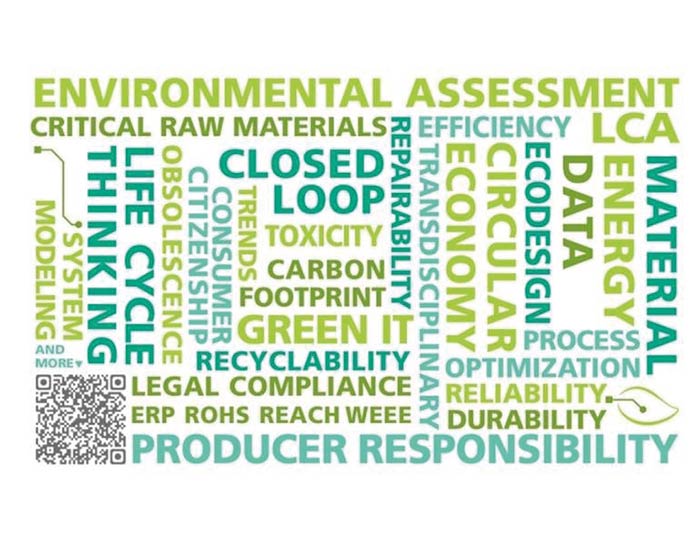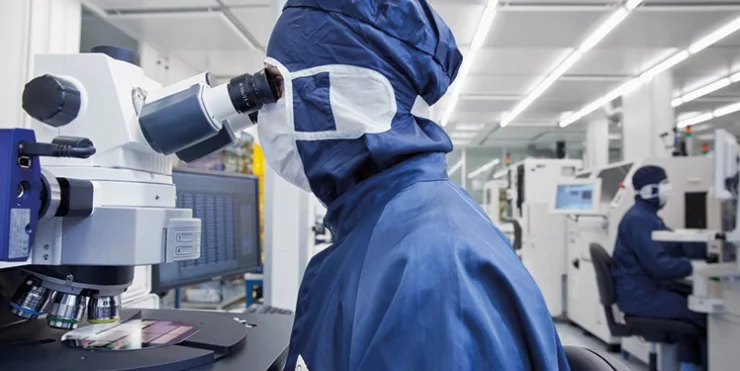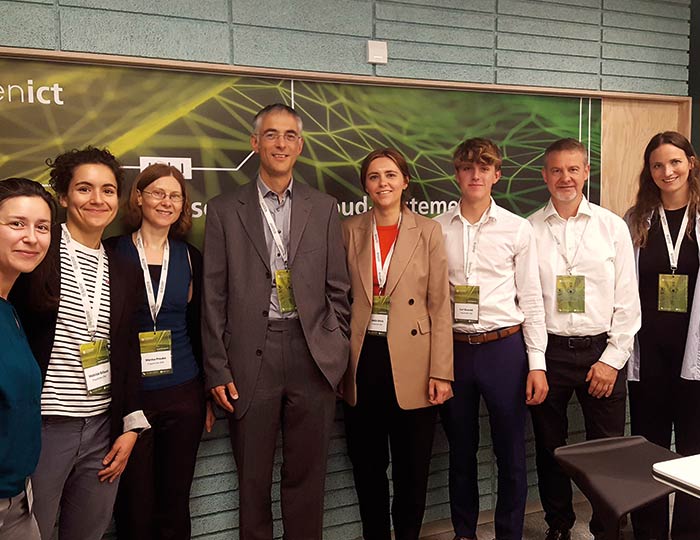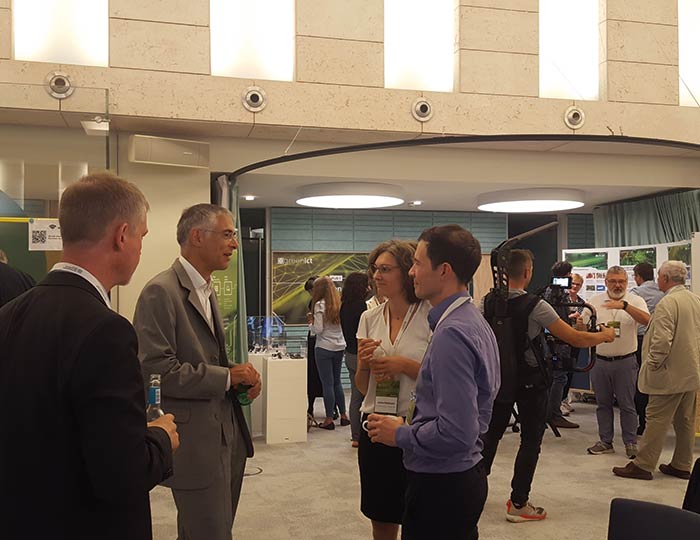RealIZM blog series »Green ICT« – Part 3
In 2022, the Research Fab Microelectronics Germany (FMD) set up the »Green ICT @ FMD« competence center as a central point of contact for companies, SMEs and start-ups concerning »sustainable electronics«. Fraunhofer IZM is part of the Green ICT Competence Center.
The RealIZM team spoke to Dr.-Ing. Nils F. Nissen, Head of the Environmental & Reliability Engineering department at Fraunhofer IZM, about the need for a cross-location competence center, the fact that modern information and communication technologies (ICT) require an increasing amount of power, as well as the environmental impact of electronics in general.
Why did you need to set up a competence center for »environmentally friendly electronics«?
Dr. Nils F. Nissen: There are several reasons why environmentally-friendly electronics are gaining more and more traction with the general public. Various environmental laws and regulations, for example, are increasing the pressure on companies to take an active role in addressing their environmental impact, and to rework or fully redesign the manufacturing processes for electronic components and products accordingly.
The development of new sensors, chips and intelligent control systems for industrial applications and smart homes, for example, is helping to save energy and non-energy resources in applications. We call this »Green-by-ICT« for short. At the same time, the increasing number of sensors and electronics in our everyday lives and the growing demand for artificial intelligence and machine learning applications are having a negative impact on the on the environment. It’s extremely important to be able to analyze and reduce the environmental impact of ICT itself, and the term »Green ICT« is used to describe this approach.
In our current ICT study by Fraunhofer IZM, we’ve unfortunately come to the conclusion that despite the fact that progress has been made in terms of miniaturization, system integration and energy efficiency, the demand for electricity when ICT is used in Germany is set to increase. This will also continue to increase our carbon footprint (CF, the sum of climate-relevant emissions), depending on whether any real progress is made with the German energy mix. This is a reversal of the trend that was seen until around 2020, when energy consumption and emissions from ICT used in Germany were falling. New solutions are required and the existing knowledge needs to be transferred to the German economy much more rapidly and more broadly to enable us to counteract this development, and in particular to support companies in overcoming these challenges.
Which research institutions are involved in the Green ICT Competence Center?
Dr. Nils F. Nissen: Our research institute – the Fraunhofer Institute for Reliability and Microintegration IZM – is part of the competence center. A total of 13 Fraunhofer and Leibniz institutes cooperate under the umbrella of Research Fab Microelectronics Germany. We are working together to carry out and promote microelectronics research that has practical applications. We pool our resources and our services to make companies fit for sustainable electronics.
Can you please elaborate on what kinds of benefits the competence center is able to provide for companies? How is the fitness program for sustainable electronics designed?
Dr. Nils F. Nissen: The competence center advises companies on Green ICT issues and supports them with technical expertise to make resource and energy consumption as environmentally friendly as possible when it comes to producing and using information and communication technologies. A prerequisite for this is for manufacturing companies to consider and understand the environmental impact of their electronic products as a whole. This is why the Environmental & Reliability Engineering department at Fraunhofer IZM provides support and training in preparing life-cycle assessments.
Many companies don’t have the testing infrastructure they need to quantify environmental improvements. We test electronics to ensure that they’re working efficiently and, if required, provide electronic circuits and modules or test environments that aren’t yet available on the market. This is how the competence center makes it easy to share expertise and allow projects that still have some way to go before they reach the market to make clear progress in the development. One of our main jobs is to put companies in touch with research institutions, as well as significant players in industry and the political sphere.
You’ve used the phrase »Green ICT« several times now. What does it actually mean?
Dr. Nils F. Nissen: We first need to draw a distinction between Green ICT and Green-by-ICT. Green-by-ICT means that an environmental benefit is achieved by using (improved) electronics in an area of application. Examples of this are the transport and construction sectors and Industry 4.0. Green ICT, on the other hand, essentially means keeping the environmental impact of producing and using information and communication technologies to a minimum. The competence center focuses on Green ICT.
There are some great examples of dematerialization and digitalization where Green-by-ICT achieves far more savings than the additional electronics used. However, this is not the case for all applications, so we’re there to oversee the technical details of how electronics are designed and used, now and in the future.
How much prior knowledge should companies have when they speak to the Competence Center about Green ICT issues?
Dr. Nils F. Nissen: The Competence Center is a technology consultancy for companies. In principle, companies can get in touch with us any time, it doesn’t matter how much they know about the concept, or how big they are. The Competence Center is aimed at companies that already have many years of experience in resource-conscious electronics. We also offer a comprehensive training and further education program for newcomers to the field.
The companies come to us with a wide range of different queries. For example, we were able to give advice on where and how a business should start to produce electronics in a way that’s more environmentally friendly, how to create complex calculations of life cycle assessments for electronics, or how electronic components can be designed and produced in such a way as to reduce their environmental impact.
What do you think is the biggest misconception about sustainable electronics?
Dr. Nils F. Nissen: I’d like to clear up a misunderstanding first of all. The fact is, there’s no such thing as 100% green electronics. An electronic product might be greener compared to previous product generations, but can never truly be green. When we researchers and companies talk about green electronics, this should always be done on a comparative basis.
Companies are currently focusing their public image on energy consumption and the carbon footprint in terms of how they manufacture and use their electronic products. In the long term, this narrow focus doesn’t go far enough. Sustainability in electronics encompasses far more than just reducing the carbon footprint, and it’s common knowledge now that the entire life-cycle of electronics needs to be taken into account as well.
Could you please expand on this point. In your opinion, what else should companies focus on when it comes to sustainable electronics?
Dr. Nils F. Nissen: Environmental science looks at the entire supply chain, including working conditions: Which mines do the raw materials for electronics come from? What about the use of toxic substances in electronics? How and in what form can certain raw materials in electronics be recycled and reused?
We really need to raise awareness in industry that all environmental impacts need to be taken into account. Focusing solely on the CO2 footprint may also be counterproductive in certain circumstances. In the worst case scenario, businesses may be tempted by the prospect of having a lower carbon footprint at the end of the process, but more toxic substances may be used as a result.

»Green electronics« is not a one-dimensional goal. | © Fraunhofer IZM
What does the term »climate neutral« mean in relation to electronics?
Dr. Nils F. Nissen: I take a critical view of the term »climate neutrality«, even though many companies use it and have set themselves the strategic goal of »becoming climate neutral«. There are industrial processes behind all electronics. High-tech electronic products and applications aren’t climate-neutral per se. There’s no such thing as a climate-neutral process, climate-neutral electronics or a climate-neutral product.
It’s a great thing to want to reduce climate emissions as much as possible, and it can be done. What remains should be compensated for by cutting down on CO2 elsewhere or removing it from the atmosphere. So, from a scientific standpoint, it’s not plausible to talk about »net zero« and demand this from suppliers across the board.
Companies need to be advised on what it really means when they claim to be climate neutral. It’s important to protect companies from claims that have been falsely attributed to them, or from those that are imposed upon them. The Competence Center helps companies to properly position themselves on the market and to put measures in place to counteract exaggerated claims from the market and major customers. We give companies the tools they need to show what their climate contribution is, how much they’ve reduced it by already, and where and how they can improve upon it in the future.
What support does Fraunhofer IZM offer?
Dr. Nils F. Nissen: Our research institute has a clear focus on integrating electronics as much as possible, particularly in what’s known as packaging technology. That being said, we also provide advice and support from an environmental perspective, whether that’s on selecting raw materials for manufacturing microelectronics, to evaluating entire products and product networks. Most important aspect of this however, is that large system analyses always need to go into the details of specific technologies, from new variants of semiconductor packages, substrates and printed circuit boards, to integrated optoelectronics and high-frequency setups. As experts in microintegration, we drive companies forward with innovative, reliable assembly and interconnection technologies where resource use is kept to an absolute minimum.
My team also produces training videos as part of the »Green ICT @ FMD« research project and we offer various face-to-face and online seminars in which we impart knowledge and skills on ecology and sustainability of electronics and take deep dives into various technical aspects.
Where and when will there be opportunities for networking and sharing ideas in 2024?
Dr. Nils F. Nissen: Two important specialist conferences are taking place in Berlin this year. In June, Fraunhofer IZM is organizing the international conference »Electronics Goes Green 2024+«. This is the world’s largest conference on environmentally-friendly electronics and an important platform for sharing information on current developments in the circular economy, sustainable use of materials and reducing CO2 in the electronics industry.
In October, »Green ICT Connect« will be taking place for the second time in Berlin. At this two-day event, speakers and participants will be presenting and discussing ideas and challenges in relation to energy efficiency, decarbonization and life cycle assessment in green ICT will be presented and discussed.
Left: The Fraunhofer IZM ERE team at Green ICT Connect 2023 | © Fraunhofer IZM I Katja Arnhold
Right: Green ICT Connect 2023 | © Fraunhofer IZM I Katja Arnhold
At the beginning of September, the Competence Center invites you to the »Green ICT Camp« to Berlin. The week-long event is aimed at students and gives them an insight into the range of research and development opportunities in the green electronics sector.
Thanks very much for speaking to us!
The Green ICT Competence Center at the Research Fab Microelectronics Germany (»Green ICT @ FMD«) is a central point of contact for sustainable electronics. The Federal Ministry of Education and Research supports the project as part of the Green ICT initiative, which is part of the German government’s 2030 climate protection programme.
Network coordinator: FMD office
Partners:
Fraunhofer EMFT, Munich; Fraunhofer ENAS, Chemnitz; Fraunhofer FHR, Wachtberg; Fraunhofer HHI, Berlin; Fraunhofer IAF, Freiburg; Fraunhofer IIS, Nuremberg; Fraunhofer IISB, Erlangen; Fraunhofer IMS, Duisburg; Fraunhofer IPMS, Dresden; Fraunhofer ISI, Karlsruhe; Fraunhofer ISIT, Itzehoe; Fraunhofer IZM, Moritzburg; Ferdinand-Braun-Institut GmbH, Berlin; IHP GmbH, Frankfurt (Oder)
BMBF funding
Duration: 08/2022-01/2026







Add comment